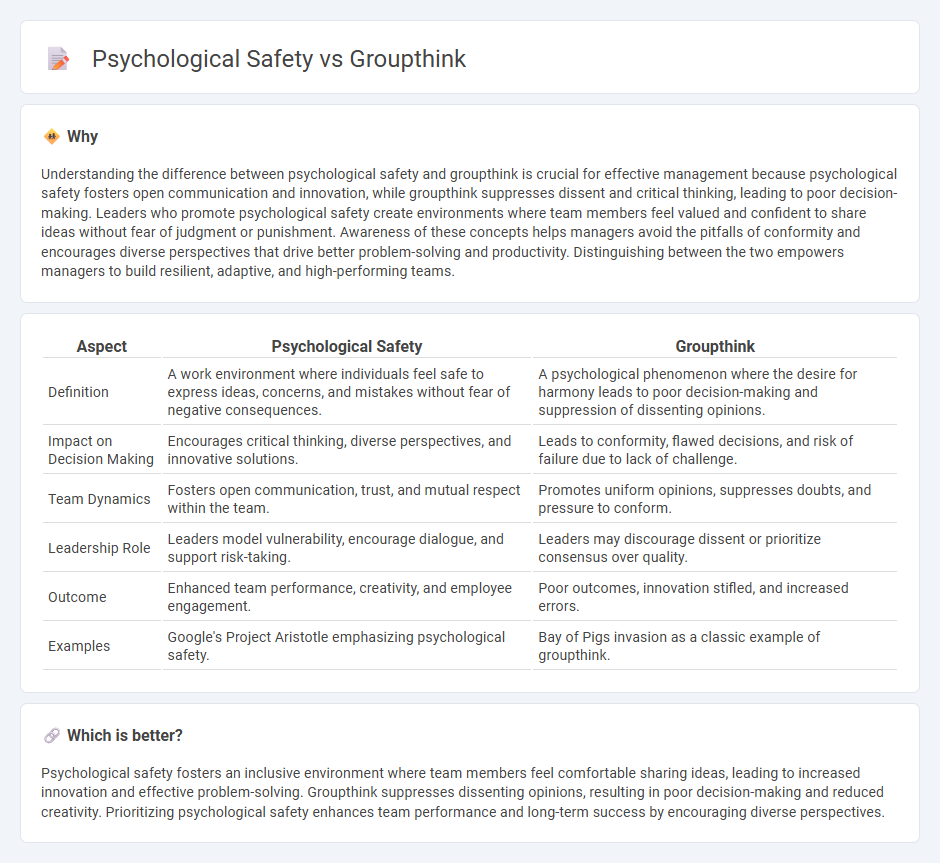
Psychological safety fosters open communication and innovation by allowing team members to voice ideas without fear of judgment, while groupthink suppresses dissent and critical thinking to maintain harmony. High psychological safety correlates with improved team performance and creative problem-solving, whereas groupthink often leads to poor decision-making and risk blindness. Explore effective strategies to cultivate psychological safety and avoid groupthink pitfalls in your management practices.
Why it is important
Understanding the difference between psychological safety and groupthink is crucial for effective management because psychological safety fosters open communication and innovation, while groupthink suppresses dissent and critical thinking, leading to poor decision-making. Leaders who promote psychological safety create environments where team members feel valued and confident to share ideas without fear of judgment or punishment. Awareness of these concepts helps managers avoid the pitfalls of conformity and encourages diverse perspectives that drive better problem-solving and productivity. Distinguishing between the two empowers managers to build resilient, adaptive, and high-performing teams.
Comparison Table
| Aspect | Psychological Safety | Groupthink |
|---|---|---|
| Definition | A work environment where individuals feel safe to express ideas, concerns, and mistakes without fear of negative consequences. | A psychological phenomenon where the desire for harmony leads to poor decision-making and suppression of dissenting opinions. |
| Impact on Decision Making | Encourages critical thinking, diverse perspectives, and innovative solutions. | Leads to conformity, flawed decisions, and risk of failure due to lack of challenge. |
| Team Dynamics | Fosters open communication, trust, and mutual respect within the team. | Promotes uniform opinions, suppresses doubts, and pressure to conform. |
| Leadership Role | Leaders model vulnerability, encourage dialogue, and support risk-taking. | Leaders may discourage dissent or prioritize consensus over quality. |
| Outcome | Enhanced team performance, creativity, and employee engagement. | Poor outcomes, innovation stifled, and increased errors. |
| Examples | Google's Project Aristotle emphasizing psychological safety. | Bay of Pigs invasion as a classic example of groupthink. |
Which is better?
Psychological safety fosters an inclusive environment where team members feel comfortable sharing ideas, leading to increased innovation and effective problem-solving. Groupthink suppresses dissenting opinions, resulting in poor decision-making and reduced creativity. Prioritizing psychological safety enhances team performance and long-term success by encouraging diverse perspectives.
Connection
Psychological safety fosters an environment where team members feel secure to express diverse ideas without fear of judgment, reducing the likelihood of groupthink by encouraging open dialogue and critical thinking. When psychological safety is low, conformity and suppression of dissenting opinions increase, leading to groupthink and poor decision-making. Effective management strategies cultivate psychological safety to enhance creativity and prevent the detrimental effects of groupthink on organizational performance.
Key Terms
Conformity
Groupthink often results from excessive conformity within a group, leading members to prioritize unanimity over critical evaluation, which can suppress dissenting opinions and reduce innovation. Psychological safety encourages open communication and risk-taking by fostering an environment where individuals feel safe to express differing views without fear of judgment or punishment. Explore how creating psychological safety can counteract the negative impacts of conformity seen in groupthink.
Open communication
Groupthink often suppresses open communication by promoting conformity and discouraging dissenting opinions, which can lead to poor decision-making in teams. Psychological safety fosters an environment where individuals feel safe to share ideas and concerns without fear of judgment, enhancing collaboration and innovation. Explore how prioritizing psychological safety over groupthink can transform team dynamics and productivity.
Decision-making
Groupthink undermines decision-making by promoting conformity and suppressing dissenting opinions, leading to flawed or suboptimal outcomes. Psychological safety enhances decision-making by encouraging open communication and risk-taking without fear of negative consequences, fostering innovation and better problem-solving. Explore how cultivating psychological safety can counteract groupthink to improve team performance and decision quality.
Source and External Links
Groupthink | EBSCO Research Starters - Groupthink is a sociological theory explaining how cohesive groups make irrational decisions due to a desire for unanimity overriding realistic appraisals.
Groupthink - Wikipedia - Groupthink is a phenomenon where groups prioritize harmony over critical thinking, leading to irrational and dysfunctional decision-making outcomes.
What Is Groupthink In Psychology? Definition & Examples - Groupthink refers to the tendency for groups to make unwise decisions by discounting alternative perspectives due to a strong desire for consensus.
 dowidth.com
dowidth.com